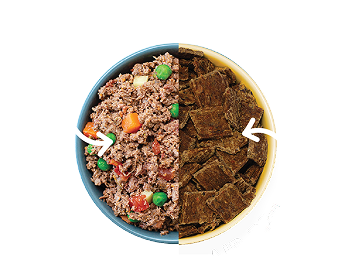
When Can Puppies Eat Dry Food?
Welcome to the world of puppy parenting! One of the first puzzles you'll encounter is figuring out when your dog is ready to start crunching on dry food.
Transitioning from mother’s milk to solid kibble is a significant milestone in your puppy’s growth journey. It's not just about giving them something new to taste but setting the stage for a lifetime of good health.
At A Pup Above, we're here to guide you through this exciting phase with ease and confidence, ensuring your pup gets the best start in life. So, let's dive into the nitty-gritty of puppy nutrition and make mealtime a breeze!
Understanding Puppy Development and Nutritional Needs
Just like little humans, puppies have unique nutritional needs that change rapidly as they grow. From the moment they're born until they're ready to wean, puppies rely heavily on their mother's milk to fuel their fast-paced development.
But as they approach a few weeks of age, a puppy’s diet evolves, requiring more diverse sources of nourishment to support their growth.
Here are the critical nutrients that every puppy needs:
- Protein: Essential for muscle growth and repair, helping your pup stay strong and playful.
- Fats: Supplies energy and helps absorb vitamins, while also keeping their coat shiny and healthy.
- Calcium: Vital for strong bones and teeth, especially important for fast-growing breeds.
- Vitamins: From Vitamin A for vision to Vitamin E for immune health, each plays an important role.
- DHA: An omega-3 fatty acid that supports brain development, making your pup as smart as they are adorable.
Getting a grip on these nutritional essentials is key to your puppy's early success. As your little one grows, moving from a liquid diet to their first time trying solid kibble isn't just a milestone — it's an adventure.
When Are Puppies Ready To Try Solid Foods?
You've got the scoop on what nutrients keep your puppy bouncing and bounding, so the next question might be, "When can they start exploring solid foods?" It's exciting to watch your pup make this big leap! Typically, puppies begin to show interest in solid food around three to four weeks old.
Here's how you can tell they're ready to start this new dietary adventure:
- Teething Time: Those little teeth starting to peek through means your puppy may be ready to manage something more substantial than milk.
- Energy Spikes: A sudden surge in activity often means they're burning through their fuel faster and could use some extra sustenance.
- Food Curiosity: If your pup starts to sniff around your meals or their siblings’ dishes, it's a good hint they're ready to try what's on the menu.
Watching for these cues can make the shift to solid foods a smooth and enjoyable part of your puppy's journey.
Picking Up on the Signs? How To Start the Weaning Process
Moving from mother’s milk to their first real bites is a big step for any puppy, and doing it right can make all the difference.
Gently Introduce Gruel
Begin the weaning by blending high-quality dry puppy food with warm water or a puppy milk replacer to create a mushy, easy-to-eat gruel. This is gentler on their little stomachs and eases the transition from liquid to solid food.
Adjust the Texture Gradually
As your puppy gets used to eating gruel, you can start thickening the consistency by reducing the amount of fresh water or milk replacer. This step-by-step process helps them adjust to the texture of solid food while ensuring they continue to eat well.
Monitor Their Acceptance
Every puppy is different. Some may dive right into new foods with gusto, while others might be more hesitant. Keep an eye on their enthusiasm and body language during mealtime to gauge how well they’re adapting to new textures and flavors.
Introduce Variety Early On
Once your puppy seems comfortable with thicker gruel, begin introducing small amounts of different types of food, including kibble and wet food. This helps them get used to various textures and flavors, making mealtime exciting and ensuring they receive all the nutrients they need.
Establish a Routine
Setting a consistent feeding schedule helps your puppy understand when to expect food and aids in digestion. As they grow, the amount of food and time spent feeding puppies will change, but establishing a routine early on keeps their little bellies happy and helps prevent overeating.
What Should You Look for When Choosing Puppy Food?
Selecting quality puppy food is like picking the first building blocks for your puppy's health and happiness.
Here's how to make sure you're getting it just right:
Start with Quality Ingredients
Good food starts with good ingredients. Look for foods that list real meat, vegetables, and wholesome grains as the first ingredients. Our sous-vide meals, like the Turkey Pilaf and Beef Pot Roast, use only human-grade ingredients, ensuring your puppy enjoys the same quality of food that you would feel comfortable eating yourself.
High Protein Content Is Key
Puppies need a lot of protein to help them grow up strong and healthy. Check that the puppy food offers a high protein content, which is essential for their muscle development and overall energy levels. Our fresh dog food not only tastes great but is packed with 70% animal protein to keep your little one thriving.
Appropriate for Their Life Stage
Puppies require different nutrients than adult dogs. Ensure the food you choose is specifically formulated for puppies, often referred to as "puppy food" or "puppy formula." This will guarantee it contains the right balance of nutrients necessary for a growing pup.
Consider Your Puppy’s Breed Size
The breed and expected adult size of your puppy can affect their nutritional needs. Large breed puppies, for instance, need a diet that supports controlled growth to help prevent bone and joint problems as they grow. Our grain-free options like the Porky’s Porchetta are perfect for keeping large and small breeds alike in optimal body condition.
Check for Allergies and Sensitivities
If your new puppy has shown signs of a sensitive stomach, you’ll want to choose a food that is easy on their digestive system. Our meals are gently cooked and slowly air-dried to preserve nutrients and enhance digestibility, perfect for puppies with a delicate tummy.
Read and Understand Food Labels
This might sound daunting, but it's easier than you think. Labels can tell you a lot about the quality of the food inside the bag. Look for clear, straightforward ingredient lists and certifications like non-GMO or USDA-approved facilities, just like ours.
Setting Up Your Puppy’s Feeding Schedule With Ease
Here at A Pup Above, we're big on keeping things simple and sweet, especially when it comes to helping you navigate the early days of puppy parenting. That's why we've whipped up a straightforward feeding chart to take the guesswork out of meal times.
This easy guide will ensure your little furball gets just the right amount of food at just the right times, supporting their growth and keeping those tails wagging.
- 3-4 Weeks Old: Start with a soft gruel mixture fed four times a day. This can be easily made by blending a high-quality dry puppy food with some warm water or puppy formula, making it the perfect first food for your pup's little belly.
- 5-8 Weeks Old: As their teeth get stronger, gradually decrease the gruel's moisture content. You can begin introducing slightly more textured food, still feeding about four times a day.
- 2-6 Months Old: It's time to transition to a more structured feeding routine with three meals a day. Keep monitoring their growth and adjust portions as necessary, especially if you notice rapid weight changes.
- 6 Months to 1 Year: Continue with three meals a day until about six months of age, then switch to two meals a day. This helps them get used to the feeding schedule for adult dog food that they'll follow for the rest of their lives.
Remember, every puppy is unique, so while this chart offers a general guideline, be sure to tailor it to your puppy’s specific needs and consult with your vet if you’re ever in doubt.
Wrapping It Up
So, when is it time for your puppy to start crunching on that dry kibble? Once they begin showing signs like teething, increased activity, and curiosity about food around three to four weeks old, you can start introducing dry dog food, easing into a routine that suits their growing needs. At A Pup Above, we're here to support all dog owners with top-notch, human-grade dry dog food that makes mealtime as delightful as it is nutritious.
Ready to give your pup the best start? Explore our range of pet food today and see why pups (and their parents!) love our dry kibble. Let's make every meal a stepping stone to a healthy, happy life for your dog.
Sources:
The Importance of Marine Omega-3s for Brain Development | PCM
Proper Puppy Nutrition Nourishes Rapid Growth & Development | American Kennel Club
Understanding Dog Body Language: Decipher Dogs' Signs & Signals | AKC
Top Stories

Why Do Dogs Lick Their Paws?

Why Do Dogs Whimper & Make Noises in Their Sleep?

Healthy Vet-Approved Homemade Dog Food Recipes

How To Cook Sweet Potatoes for Dogs






















